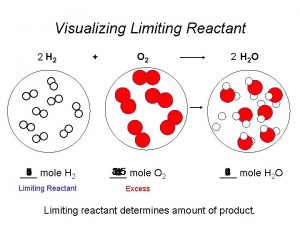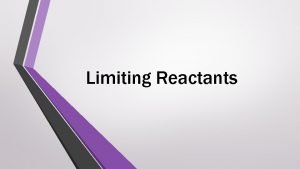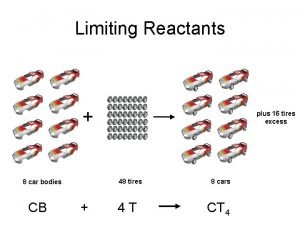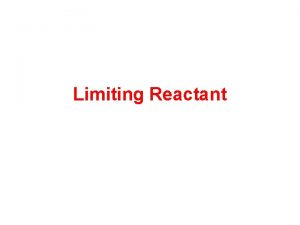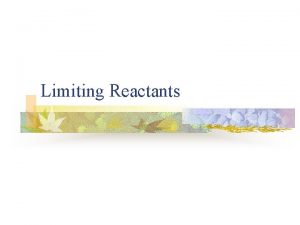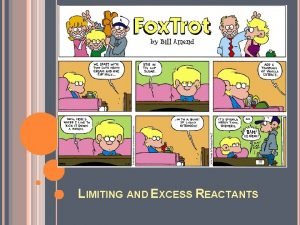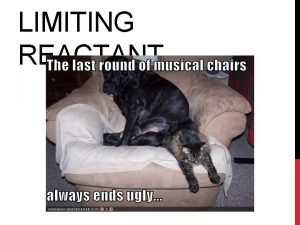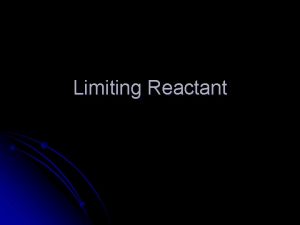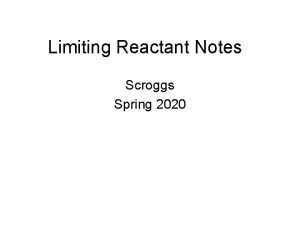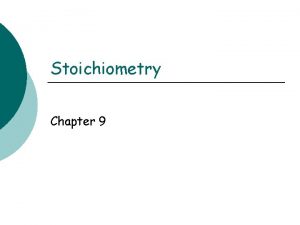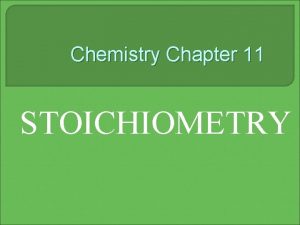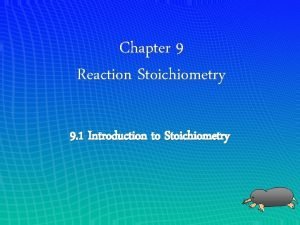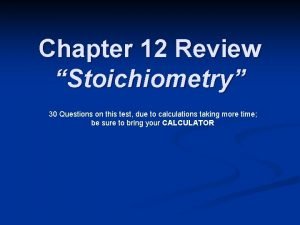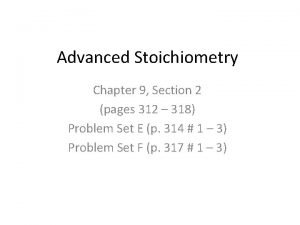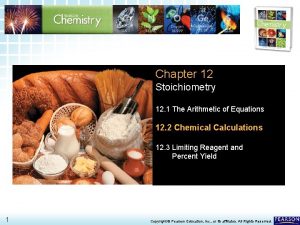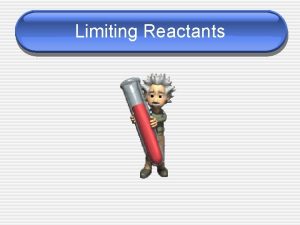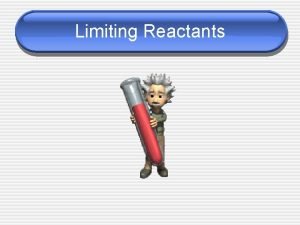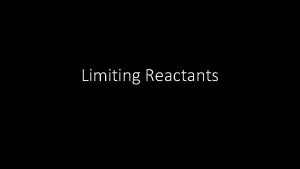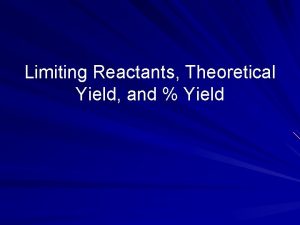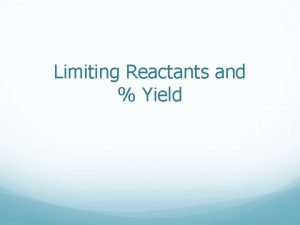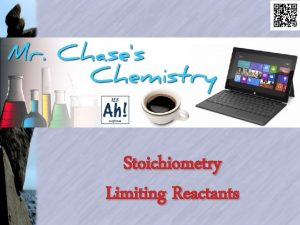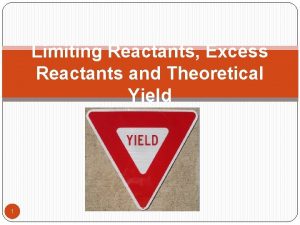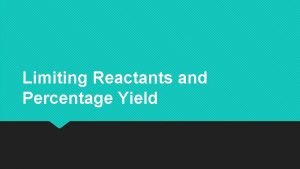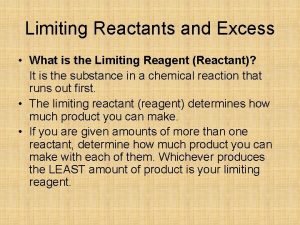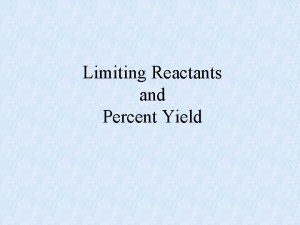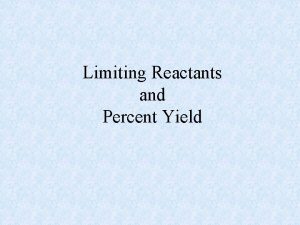Chapter 11 Stoichiometry Sec 11 3 Limiting Reactants


















- Slides: 18

Chapter 11: Stoichiometry Sec. 11. 3: Limiting Reactants

Objectives § Identify the limiting reactant in a chemical equation. § Identify the excess reactant and calculate the amount remaining after the reaction is complete. § Calculate the mass of a product when the amounts of more than one reactant are given.

Limiting Reactants If I want to make s’mores, does it matter how many marshmallows I have if I only have one piece of chocolate? No!! I will use up the chocolate & there will be marshmallows left over!

Limiting Reactants – p. 379, Fig. 4 § If I have 10 screwdrivers, 5 pliers, & 4 hammers, how many tool sets could I make? § Each tool set consists of 2 screwdrivers, a pliers and a hammer. § The hammers are used up. The number of hammers limits how many sets can be made. § There are leftover pliers and screwdrivers. There is an excess of these tools.

In Chemical Reactions: § A reaction will proceed until one reactant is used up. § The amount of product formed depends upon the reactant that is limited. When this reactant is used up, the reaction stops. § The limiting reactant is the reactant that limits the extent of the reaction and determines the amount of product formed.

In Chemical Reactions: § When the limiting reactant is used up, a portion of all of the other reactants will remain after the reaction stops. § These left-over reactants are called excess reactants.

Consider this reaction: 3 H 2 + 3 N 2 --> 2 NH 3 + 2 N 2 Visualize all the nitrogen and hydrogen atoms separating. The atoms are then available to reassemble into molecules (like the tools are assembled into kits. ) Only two ammonia molecules can be assembled because there are 6 hydrogen atoms and each ammonia molecule requires 3! When the hydrogen is gone, some nitrogen atoms remain unreacted. Hydrogen is limiting and nitrogen is in excess.

Determining the limiting reactant & amount of product § If 200 g of sulfur reacts with 100 g of chlorine, what mass of disulfur dichloride is produced? S 8(l) + 4 Cl 2(g) → 4 S 2 Cl 2(l) Remember: The amount of product depends on the reactant that is limited. Finding that is your first step!

S 8(l) + 4 Cl 2(g) → 4 S 2 Cl 2(l) § From the masses of reactants given, determine the number of moles of reactants l l 100 g Cl 2 x 1 mol = 1. 41 mol Cl 2 71 g 200 g S 8 x 1 mol = 0. 779 mol S 8 256. 8 g

S 8(l) + 4 Cl 2(g) → 4 S 2 Cl 2(l) § Next, determine whether the 2 reactants are in the correct mole ratio. The equation indicates that the ratio of chlorine to sulfur is 4: 1. Find the actual mole ratio by dividing the mole values you just calculated. l 1. 41 mol Cl 2 = 1. 81 mol Cl 2 0. 779 mol S 8

The Limiting Reactant l l l This means that 1. 81 mol of chlorine is available for each mole of S 8. The mole ratio says we need 4 chlorine for 1 sulfur. There is not enough chlorine to use up all the sulfur so chlorine is the limiting reactant!!

Practice Problems § Identify the limiting reactant when 3. 50 g of HCl reacts with 5. 28 g of Na. OH to produce Na. Cl and water. § Identify the limiting reactant when 1. 22 g O 2 reacts with 1. 05 g H 2 to produce water.

Determining the amount of product § Since the limiting reactant determines the amount of product formed, the amount of product can be determined when the limiting reactant is known. § The moles of the limiting reactant will be our “known” in a standard stoichiometric calculation. The mass of the product is the unknown.

Let’s use the example from before. We determined that Cl 2 was limiting and that there were 1. 41 mol of it. S 8(l) + 4 Cl 2(g) → 4 S 2 Cl 2(l) 1. 41 mol l 1. 41 mol Cl 2 x 4 mol S 2 Cl 2 4 mol Cl 2 x 135. 2 g = 191 g S 2 Cl 2 1 mol ? Grams

Practice Problems § Determine the mass of tetraphosphorus decoxide formed if 25. 0 g of phosphorus (P 4) and 50. 0 g oxygen are combined. P 4 + 5 O 2 --> P 4 O 10 § In photosynthesis, 6 CO 2 + 6 H 2 O --> C 6 H 12 O 6 + 6 O 2. If a plant has 88. 0 g of CO 2 and 64. 0 g H 2 O available, what mass of glucose will be produced?

Excess Reactants § Once the limiting reactant has been determined, it is also possible to use stoichiometry to find out how much of the excess reactant is used or how much is leftover. § Recall this reaction: S 8(l) + 4 Cl 2(g) → 4 S 2 Cl 2(l) We determined the limiting reactant is chlorine, with the amount of 1. 41 moles.

S 8(l) + 4 Cl 2(g) → 4 S 2 Cl 2(l) • With the known of 1. 41 mol chlorine, we can determine the no. of moles and grams of sulfur that will be used: 1. 41 mol Cl 2 x 1 mol S 8 = 0. 353 mol S 8 4 mol Cl 2 0. 353 mol S 8 x 256. 8 g = 90. 7 g S 8 USED 1 mol • Subtract to get the amount that is left over: 200 g (the original amount of S 8) – 90. 7 g = 109. 3 g LEFTOVER

Practice Problems 1. What mass of SO 3 is produced from the reaction of 10. 5 g of SO 2 and 4. 32 g of O 2? How much of the excess reactant is left when the reaction is complete? 2. If 8. 0 g of Cr is heated with 16. 7 g of Cl 2, what mass of Cr. Cl 3 will be produced? What is the excess reactant and how much of it is used in the reaction?
 Xg-125g2
Xg-125g2 Activity 2 limiting reactants activity
Activity 2 limiting reactants activity Pancake chemical formula
Pancake chemical formula Limiting and excess reactants race car answers
Limiting and excess reactants race car answers Limiting reactants practice worksheet
Limiting reactants practice worksheet Limiting reactants definition
Limiting reactants definition Excess reactant calculation
Excess reactant calculation Limit reactant
Limit reactant Determine the limiting reagent
Determine the limiting reagent Limiting reagent vs limiting reactant
Limiting reagent vs limiting reactant Chapter 11 assessment chemistry
Chapter 11 assessment chemistry Chemistry chapter 9 stoichiometry
Chemistry chapter 9 stoichiometry Modern chemistry chapter 9 stoichiometry
Modern chemistry chapter 9 stoichiometry Stoichiometry defintion
Stoichiometry defintion Chapter 9 review stoichiometry
Chapter 9 review stoichiometry Chapter 9 review introduction to stoichiometry
Chapter 9 review introduction to stoichiometry What is the first step in most stoichiometry problems
What is the first step in most stoichiometry problems Chapter 9 section 2 stoichiometry
Chapter 9 section 2 stoichiometry Chapter 12 stoichiometry answer key pearson
Chapter 12 stoichiometry answer key pearson
